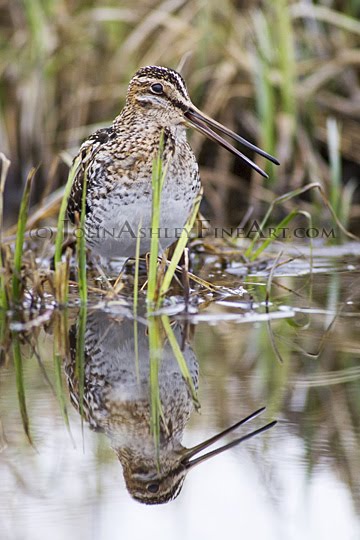 Grab your gunny sacks, we're going on a Snipe hunt -- with a camera. If you've ever found yourself crawling around blindly, waiting for your laughing friends to herd a secretive little bird into your bag, then you'll appreciate my efforts to find a real Snipe nest in our little marsh. The odds of success are roughly the same in both cases.
Grab your gunny sacks, we're going on a Snipe hunt -- with a camera. If you've ever found yourself crawling around blindly, waiting for your laughing friends to herd a secretive little bird into your bag, then you'll appreciate my efforts to find a real Snipe nest in our little marsh. The odds of success are roughly the same in both cases. Snipe live in marshy areas that have thick, grassy vegetation and no trees. They eat mostly worms and insects that they find by probing deep in the mud. I challenge you to picture this without laughing -- a Snipe's long bill is flexible, like lips, and when feeding they can open and close the tip without moving the base. (Maybe AFLAC should have used Snipe for their spokes-bird instead of that duck.)
 Another unusual Snipe trait is their division of parental labor. The male takes the first two chicks that hatch, the female takes the last two chicks, and they raise their young alone as single parents. Always having their offspring in two different locations increases the parents' odds of passing on at least some of their genetics.
Another unusual Snipe trait is their division of parental labor. The male takes the first two chicks that hatch, the female takes the last two chicks, and they raise their young alone as single parents. Always having their offspring in two different locations increases the parents' odds of passing on at least some of their genetics.Males and females look the same (she's a little bigger) but they have very different duties. The female tends to their nest, hidden away under last year's dried stalks. But she can't see an approaching threat while she's incubating. So the male patrols the marsh around the nest, updating his mate with frequent calls. When alerted by her mate, she slips away under the tall grass without giving up the nest location.
Behind the lens: Photographed from some really gooey mud with a Nikon D700, 500mm f4 lens, and a muddy monopod.


